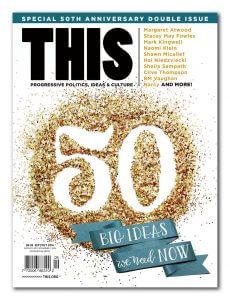Canada needs Wi-Fi-free preserves
How to fight light pollution and more in our country
Andrew Potter@jandrewpotter
 For our special 50th anniversary issue, Canada’s brightest, boldest, and most rebellious thinkers, doers, and creators share their best big ideas. Through ideas macro and micro, radical and everyday, we present 50 essays, think pieces, and calls to action. Picture: plans for sustainable food systems, radical legislation, revolutionary health care, a greener planet, Indigenous self-government, vibrant cities, safe spaces, peaceful collaboration, and more—we encouraged our writers to dream big, to hope, and to courageously share their ideas and wish lists for our collective better future. Here’s to another 50 years!
For our special 50th anniversary issue, Canada’s brightest, boldest, and most rebellious thinkers, doers, and creators share their best big ideas. Through ideas macro and micro, radical and everyday, we present 50 essays, think pieces, and calls to action. Picture: plans for sustainable food systems, radical legislation, revolutionary health care, a greener planet, Indigenous self-government, vibrant cities, safe spaces, peaceful collaboration, and more—we encouraged our writers to dream big, to hope, and to courageously share their ideas and wish lists for our collective better future. Here’s to another 50 years!
At the core of the Canadian mindset is a deep-seated ambivalence about nature. From the earliest days of the fur trade, this country has been tugged in two directions: by the timeless pull of the deep wilderness, and the ceaseless desire to tame it through technology. Take our national parks. They’re places where we pay homage to both the comforts of modernity and the romantic notion that something worthwhile of the past has been lost along the way: freedom, equality, solidarity, communal self-reliance—perhaps even a basic understanding of our place in the universe.
A team of scientists recently released an atlas of the night sky, showing the varying levels of artificial light pollution around the world. Their conclusion was that one-third of humanity—including 80 percent of North Americans—can’t look up and see the Milky Way at night.
The researchers warn of the impact this perma-glow might have on our health (it messes up our circadian rhythms) or on wildlife (it messes up theirs). But there’s a more existential concern, which is that it causes us to lose our sense of our true place in creation. Cut off from the movement of the planets and the twinkling stars above, we live in a universe that is fundamentally different from the one that every generation before us experienced.
Interestingly, Canadians have long been at the forefront of efforts to mitigate the effects of light pollution. The first permanent “dark sky preserve” was established near Muskoka in 1999, and, thanks to the work of the Royal Astronomical Society of Canada, we have established the first (and to date, only) formal standards for dark sky preserves.
Even as we fight the scourge of light pollution, we’re rapidly building the infrastructure for a far more insidious and existentially threatening form of pollution, in the form of electromagnetic radiation. The problem isn’t just routine smartphone addiction, nor is it our increasing reliance on apps to help us find love and then the way to our lover’s house. We’ve built the internet of words and images, and we are rapidly moving on to the internet of things and even the internet of animals. The intersection of “things that exist on Earth” and “things that are connected to the internet” will soon not distinguish two important classes of objects.
This implies nothing short of the complete domestication of the natural world. Maybe that’s where things are headed, but that doesn’t mean there’s no value in preserving some sense of nature as a place of otherness.
We already have building blocks of a model for how to do this: national parks wedded to dark sky preserves. We just need to take it a step further and create electromagnetic radiation-free zones where there’s no WiFi, your iPhone can’t get a signal, and even a satellite phone is an expensive paperweight.
Canada should set aside huge tracts of the country where electronics don’t work. We could call them Faraday Preserves, after the scientist Michael Faraday who in 1936 invented mesh enclosures that could block radio waves. They could be places where technological development is flash-frozen at the cusp of the industrial revolution, before the electricity-driven compression of space and time.
The idea will seem preposterous to both modernists and romantics. Modernists will see it as a hopelessly nostalgic rejection of humanity’s greatest gifts, while the romantics will see it as the equivalent to a technological zoo, a sort of Upper Canada Village meets Survivor. But done correctly, it would be neither. Instead, it would be a place where humans could go to get back in touch with who we essentially are: not positioned like a godhead at the top of a great chain of being, but mere bits of matter in motion in a meaningless universe.
Kurtz went up the river to discover that there is little difference between civilization and savagery. Faraday Preserves could be our own hearts of darkness, beating quietly amidst the networked cacophony.
Illustration by Matthew Daley
Andrew Potter is a past member of the editorial board of This Magazine. He is the former editor of the Ottawa Citizen and the current director of the McGill Institute for the Study of Canada.